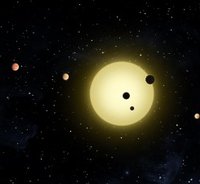
The dawning era of exoplanet exploration has yielded up many surprises in the form of classes of planets that have no counterpart in our own Solar System. In this talk, I will discuss a class that I refer to as “gas midgets,” which consist of planets in the Super-Earth range of masses or radii, but which have densities so low that most of the planet’s mass must be in the form of volatiles. The poster-child for this class of planets, and the first such to be discovered, is GJ1214b, with a mass of 6.55 Earth masses, a radius of 2.678 Earth radii and a density of only 1870 kilograms per cubic meter. It turns out that GJ1214b is not alone, and a number of other planets in its class have been discovered. Some of these could have hydrogen-rich envelopes, but this model has been essentially ruled out for GJ1214b, for which transit-depth observations point towards a composition with higher molecular weight. The conventional picture of this planet consists of a water-world, but based on work by James Lloyd and myself I will put the case for a carbon-rich planet whose composition is dominated by carbon dioxide surrounding a silicate core.
Many gas midgets are not good candidates for habitability in the conventional sense, but they do provide a valuable check on theories of photoevaporation and atmospheric escape. This is important because the main threat to habitability of planets orbiting M-stars is loss of atmosphere due to the high extreme ultraviolet flux expected for such stars, at least in their youth; were it not for the risk of atmospheric escape, M-star systems would provide the most widespread and stable liquid water habitat in the Universe. There is one class of gas midgets, however, discussed by Eric Gaidos and myself, which not only are potentially habitable but in fact expand the habitable zone to distances far beyond the limits traditionally imposed by carbon dioxide condensation. These are the planets whose density may be explained by a model consisting of a silicate core surrounded by a thick hydrogen atmosphere. The existence of gas midgets in quite close orbits confirms the potential for such atmospheres to be retained. Confirmation by spectroscopic observations that some gas midgets do indeed have a hydrogen envelope would provide support for the existence of this new class of habitable worlds. I will discuss the kinds of biogeochemical cycles that might exist on such worlds, and raise the question of whether their habitability could survive the emergence of life.
 A Talk With Jim Green
A Talk With Jim Green What Can Extant Genomes Reveal About Early DNA Metabolism?
What Can Extant Genomes Reveal About Early DNA Metabolism? What We Talk About When We Talk About Earth's Oxygenation
What We Talk About When We Talk About Earth's Oxygenation Bowling With Astrobiologists: A Twisted Path Toward the Origin of DNA
Bowling With Astrobiologists: A Twisted Path Toward the Origin of DNA